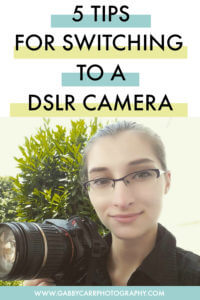Like many people I started out shooting with a simple point and shoot camera. It was a really good camera, and I was able to get some really great pictures with it. I even launched my business using it as my primary shooter, but it wasn’t long until I outgrew it as I began to mature as a photographer. I decided I needed a good DSLR camera in order to continue growing and learning. There were a few growing pains as I stepped outside my comfort zone and made the switch. Here are a few things I learned along the way, from buying my DSLR to leaning how to connect meaningfully with my new baby.
Kits are your friend
There are many great options out there for all sorts of camera bodies and lenses. I was a little overwhelmed trying to choose what I wanted to go with and making sure I had everything I needed. Camera kits are really great when you’re getting your first DSLR because you can get the body, a couple of lenses, and a bunch of accessories all in one go. Down the road, once you’re more practiced and have learned a little more what you need/what you like, then you can add another lens or filter or a different flash or tripod to your collection.
Buy Refurbished
A good DSLR camera can get expensive. A safe way I’ve found to still get the camera I want without compromising quality or confidence is to buy a refurbished product. When I buy an authorized refurbished product I can be completely confident that it works the way it is supposed to, and if for some reason it doesn’t, I can still go to the manufacturer, and they’ll work with me and back their product. It’s very important, though, that you get it from an authorized retailer or straight from the company itself. Sure, you may find a really great deal on a camera on craigslist, but if it doesn’t work like it should you’re out of luck, and out of at least a couple hundred dollars.
Don’t get stuck on automode
It’s really tempting when you first get your DSLR to stay in the safe auto mode instead of learning all the complicated bits, but that is a huge mistake! Manual mode allows you to get what you want when you want, whether it’s getting that super blurred background or changing how flowing water looks in your pictures. Auto mode can be good and helpful, but it often ends up like a crutch that keeps you from actually learning how to walk.
Take advantage of your many resources
Manual mode can be really intimidating, but the great thing is that there’s so many resources out there to help you! You can often find camera specific tutorials on Youtube. Pinterest can be a budding photographer’s best friend by helping to find all sorts of articles about the differences between ISO and field depth and aperture. I was even able to find flash cards to help me learn how to set my camera settings for all different situations and for specific shots I was trying to get. I was able to learn so much on how to take my pictures to how to edit them all by simply googling.
Don’t stop taking pictures
When you first start shooting it can be really disheartening how many pictures won’t come out the way you want them to. When I first started local family photography, my good picture to bad picture ratio was not where I wanted it to be. It was frustrating when I’d take nearly a hundred pictures but would only like the look of maybe ten. The solution for me was to take even more pictures! Instead of taking just a hundred pictures I would take two hundred! Even though my ratio wasn’t where I liked, I still would get more good pictures. I’m not saying to just shoot randomly and hope for the best. I still planned my shots and shot with purpose, but as I got more practice and played my odds, I ended up getting better and getting more photographs that I didn’t hate to look at and enjoyed giving to my customers.
You may be making the jump to a DSLR for any number of reasons. Maybe you like the extra control you have over the different settings, or maybe you need more professional quality photos than a more basic point and shoot cameras can give you. If you are ready to take the plunge, hopefully these tips will help the transition go a little smoothly for you. If you’re not ready for the transition: don’t worry. You can still stick with your point and shoot and still get some great pictures. Either way, Happy Shooting!
